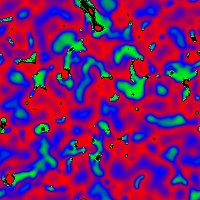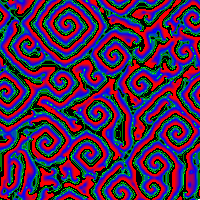fundamentals Zhabotinsky
The name of this CA is based on the Belousov-Zhabotinsky-reaction, a well known chemical oszillator.
To simulate this chemical reaction i used the "Misch-Masch-Maschine" by Martin Gerhardt and Heike Schuster:
cells may have states of 0 (healthy), 1 to 255 (infected) and 256 (ill).
A cell of state 0 (healthy) will get the state [K/k1] + [I/k2] in the next generation.
K=sum of ill neighbors, I=sum of infected neighbors,
k1 = illness threshold (1-5), k2 = infect threshold,
the square brackets rounding off to integer.
Infected cells (state 1-255) go to [S/A] + g, but max 256 in the next generation.
S = sum of the values from all neighbors and the cell itself. A is the number of these cells. [S/A] is just the mean value.
g = constant (1-120) allways added, it is a kind of stimulation.
An ill cell (state 256) will be healthy (state 0) in the new generation.
In this automaton you may define the neighborhood freely!
The simulation is running on a closed Area (Toroid).
This process may be described in this words:
- healthy cells will be infected by infected and ill neighbors.
- infected cells are powered by a mechanism of stimulation and diffusion until the cell is ill.
- "ill" cells will be healthy immediately and the process starts again.
There are generated a lot of pattern, depending of the parameter k1, k2, and g, but of the starting states also.
Below you see 2 typical examples:

k1=3, k2=2, g=5

k1=3, k2=2, g=64

